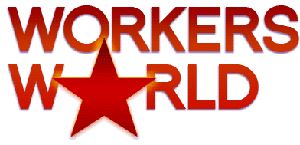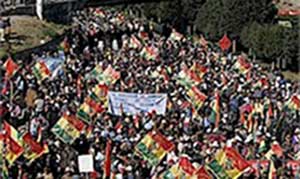
Follow workers.org on



RED HOT: TRAYVON MARTIN
CHINA,
AFGHANISTAN, FIGHTING RACISM, OCCUPY WALL STREET,
PEOPLE'S POWER, SAVE OUR POST OFFICES, WOMEN, AFRICA,
LIBYA, WISCONSIN WORKERS FIGHT BACK, SUPPORT STATE & LOCAL WORKERS,
EGYPT, NORTH AFRICA & MIDDLE EAST,
STOP FBI REPRESSION, RESIST ARIZONA RACISM, NO TO FRACKING, DEFEND PUBLIC EDUCATION, ANTI-WAR,
HEALTH CARE,
CUBA, CLIMATE CHANGE,
JOBS JOBS JOBS,
STOP FORECLOSURES, IRAN,
IRAQ, CAPITALIST CRISIS,
IMMIGRANTS, LGBT, POLITICAL PRISONERS,
KOREA,
HONDURAS, HAITI,
SOCIALISM,
GAZA



|
|
U.S.-supported ‘referendum’
Oligarchs trying to break up Bolivia
By
Berta Joubert-Ceci
Published May 8, 2008 10:00 PM
On May 4, massive demonstrations of Indigenous people, peasants, workers and
students took place all over Bolivia to protest an attempt by wealthy
landowners and business heads to divide their country. These demonstrations got
little attention in the international media emanating from the imperialist
countries.
|
Mass demonstration in support
of national unity.
Photo: Granma.cu
|
What they focused on instead was the “referendum for autonomy” in
the province of Santa Cruz, which had been declared illegal and
unconstitutional by the progressive government of Evo Morales.
The Indigenous people in Bolivia have been ignored, persecuted and exploited
for 500 years. But today they are defending their rights, the unity of their
country, and the national government led by Morales, Bolivia’s first
Indigenous president.
U.S. imperialism has been carefully orchestrating a divisive strategy in
Bolivia that it plans to apply in other countries of the region as well,
including Ecuador and Venezuela. Santa Cruz is one of nine Bolivian provinces.
The vote for “autonomy” is meant to destabilize the Morales
government and divide the country, much as Kosovo was separated from
Yugoslavia. In fact, some of the same actors are busy at work in Bolivia. The
current U.S. ambassador there is Philip Goldberg, who was instrumental in the
separation of Kosovo.
Concentrated wealth
Santa Cruz, in the eastern lowlands of Bolivia, is part of the Media Luna (half
moon)—a crescent that includes the provinces of Pando, Tarija and Beni.
The Media Luna is also the wealthiest part of the country, generating 44
percent of the gross national product. A right-wing opposition to the Morales
government is entrenched there, with its leadership centered in Santa Cruz.
Santa Cruz is the largest province in Bolivia, with almost one third of the
national territory. Its capital, Santa Cruz de la Sierra, is the largest city
in the country, with nearly 1.4 million people. Santa Cruz alone generates
30.63 percent of the GNP.
Home to a white European oligarchy, it is also vehemently racist. Many of the
oligarchs are “latifundistas” who own huge farmlands that produce
export goods like soy, rubber and cattle.
One of those landowners is Ronald Din Larsen, a U.S. citizen who has lived in
Bolivia for many years and owns 141,203 acres in Santa Cruz. According to
Bolivian authorities, Larsen doesn’t even have a Bolivian registration or
identity card, yet his family is actively opposing the land reform proposal of
the Morales government that would break up these large estates and make land
available to poor Bolivians. When Vice-Minister of Land Alejandro Almaraz made
a recent visit to Santa Cruz, he was attacked by a gun-toting group instigated
by Larsen, according to the news agency ABI.
Santa Cruz is where most of the transnational corporations have their
headquarters. It also has the largest reserves of natural gas, petroleum and
other minerals.
The province’s business owners are organized in the Santa Cruz Civic
Union, headed by Branko Marinkovic, a Croatian capitalist with close ties to
the U.S. Embassy. Carolus Wimmer, national secretary of the Venezuelan
Communist Party, told Venezuelan television that some members of the Croatian
oligarchy in Bolivia had been expelled from Socialist Yugoslavia after World
War II as fascist sympathizers. The Croats settled in several Latin American
countries with the help of the CIA.
Marinkovic and Rubén Costas, the administrator of the province, are the
leaders behind the separatist movement in Santa Cruz. Their armed wing, the
Santa Cruz Youth Union, is a violent group closely allied to the Falange, a
fascist organization active in the 1940s and 1950s that seems to be
resurfacing.
In search of jobs, thousands of people from the highlands in the west have
moved to Santa Cruz, particularly members of the Indigenous Aymara and Quechua
nations. In Santa Cruz they face discrimination and often racist violence,
perpetrated mostly by the fascist youth group.
Illegal referendum
The referendum on autonomy was illegal under the Bolivian constitution. Even
the United Nations and the Organization of American States, no champions of
progress, opposed the referendum. Gen. Luis Trigo, head of the Bolivian Armed
Forces, publicly denounced it as affecting “the security and the defense
of the Bolivian State.” He pointed out that some of the articles
establish local control over legislation, all transport by land, river, air and
roads, as well as the airwaves, security and defense.
It is in fact a project to provide legal cover for setting up a new
country.
Informal polls show that the majority of the people in Santa Cruz did not know
the exact contents of the referendum.
In an effort to deceive, the oligarchy’s media reported on May 5 that the
“Yes” option approving autonomy won by more than 80 percent. In the
U.S., the Washington Post echoed those numbers in an article that quoted
Marinkovic as saying, “It’s a historic day, and tomorrow we have
more work to do. ... We have to determine a new course for Bolivia, and it
won’t be an easy task.”
Morales, in a televised speech, said, “This poll, which is illegal and
unconstitutional, was not the success that they hoped for. ... Between the
abstention rate of 39 percent, the votes ‘no’ and the blank
ballots, that is practically 50 percent.” The turnout for the
“referendum” had been low.
Interior Minister Alfredo Rada, in an interview with Telesur, stated that the
elections were marked by “violence, confrontations and
irregularities.” He said some names were erased from voters’ lists
and 20 people were injured in confrontations with the fascist youth group. In a
neighborhood called Plan 3000, a stronghold of the Morales party, the fascist
youth picked a fight against the Indigenous and peasant residents, shouting
racist epithets. The residents shouted back, “Get out fascists” and
“Long live Evo.”
People in Santa Cruz who support Morales had seized and burned ballot boxes in
rejection of the referendum. In the process, they found many supposedly blank
ballots were already marked with the Yes option. They immediately called the
press to announce the fraud.
In a Telesur broadcast, Morales also accused the United States of funding the
opposition. “The Embassy of the United States is the one that leads this
conspiracy,” he said, adding that “the U.S. ambassador is the great
defender of the division of Bolivia, of the anti-constitutional attitudes, of
those groups that do not want equality for our peoples, of the groups that want
to steal from our country.”
Articles from different sources mention that USAID and the National Endowment
for Democracy have given million of dollars to the opposition groups in the
name of the “fight against drug trafficking.” (See, for example,
www.coastalpost.com/08/04/18.html.)
E-mail: [email protected]
Articles copyright 1995-2012 Workers World.
Verbatim copying and distribution of this entire article is permitted in any medium without royalty provided this notice is preserved.
Workers World, 55 W. 17 St., NY, NY 10011
Email: [email protected]
Subscribe [email protected]
Support independent news DONATE
|
|


